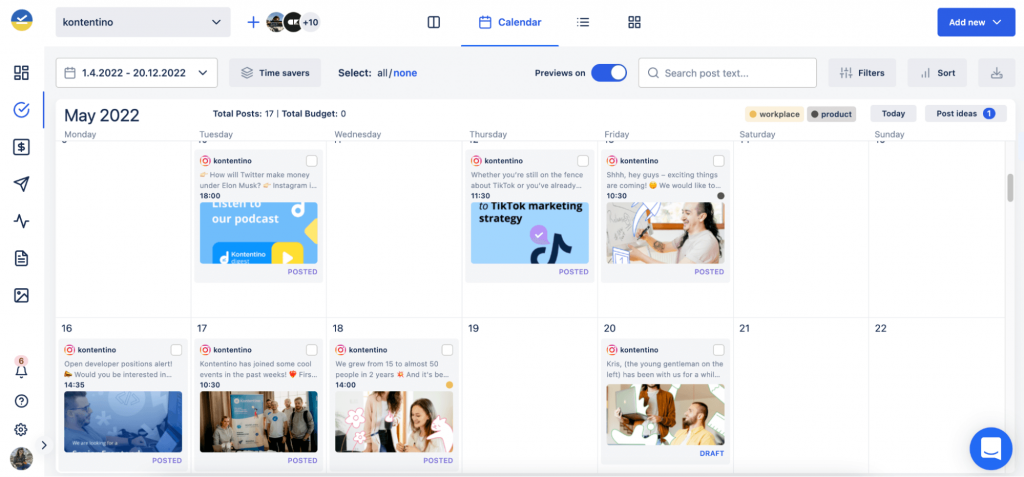There is a real challenge for brands to make their mark and dominate their market on social media today. It’s harder than ever for brands to assert themselves and create a niche that not only engages with their audience, but inspires and adds value so that they recognize and return to your social home.
Even though attention has become the new currency, we have to remember that trust is its foundation, and developing a social media campaign strategy that feels authentic and unique to your brand is important. While it’s no longer enough to simply have a digital presence, the way a brand utilizes its presence is what really defines its impact.
What is a social media campaign?
A social media campaign is a coordinated marketing effort across platforms like Facebook, Instagram, Twitter (X), and others to promote a specific message or goal.
Instead of regular posts that maintain a brand’s presence and daily engagement, a social media campaign operates with a defined beginning and end, a clear purpose, and outlines metrics for success to review and refine for future campaigns.
Often, a social media marketing campaign will revolve around key product launches, promotional events, or even social causes that the brand aligns with. They demand meticulous planning, a deeper understanding of the target audience and the chosen platforms, and of course, optimized creative content to ensure the desired impact on each specific social media platform.
It’s essential to remember that the effectiveness of a social media campaign isn’t just in its visibility. It also lies in its ability to evoke a desired response or action from the audience. Using this data for a competitive analysis is important to determine success, and help you to refine for the next social media campaign.
Whether it’s generating leads, driving sales, or increasing event registrations, a well-executed social media marketing campaign has the power to significantly boost a brand’s objectives in a short span.
How to Create a Social Media Campaign That Will Bring Results
Define Your Campaign Goals
Successful social media campaigns stem from clearly articulated objectives, and the best way to start is to ask yourself a simple question: “Why am I running this campaign?”. By defining this, you’ll better understand the next steps to take for your social media strategy and refine your campaign content.
Ensure that you are specific with your objectives, with measurable outcomes. Instead of aiming at a vague goal like “increase brand awareness”, opt for tangible targets like “reach 50,000 new followers in the next three months” or “achieve a 10% increase in website traffic via social referrals.”
When you start with precise objectives, it’s easier to align resources, craft fitting content, and measure success down the line.
Understand your target audience
Social media marketing campaigns benefit from a deep understanding of who the audience is, and you can use the insights provided by platforms to develop audience personas.
To identify your audience, you should:
- Look at the age, gender, location, and interests of your followers.
- See what kind of content they engage with the most.
- Pay attention to the hashtags they use and the conversations they participate in.
- Use social listening tools to track mentions of your brand and industry.
- Compare your insights to those of your competitors to see where you can improve your targeting.
An audience persona is a fictional representation of your ideal customer. It is based on real data about your existing customers, as well as your target market research. The persona should include information about your desired customer, and include information that you have gleaned from social listening, such as conversations about trends or your brand.
This will help you develop a social media marketing campaign that includes not only their basic demographics, but also their interests and understanding of the content that they prefer to engage with. As a result, your social media campaigns should be more effective.
Choose Your Social Media Channels
Having a good understanding of the social media channel(s) that you want to use is important for your social media marketing campaign.
The audience and purpose of each platform differs – for example, if your target audience is Gen Z, you might want to focus on TikTok and Instagram. If your audience is B2B decision-makers, you might want to focus on LinkedIn.
When devising your social media marketing strategy, it’s best to focus on the platforms that are most relevant to your target and audience persona.
You can also look at your past website analytics to see which platforms have been most effective in driving traffic and leads for previous social media campaigns. This can help you identify the channels that are worth investing in for your campaign.
And it’s not just about choosing the most popular platforms; it’s about identifying where your target audience spends most of their time. Using a social media management tool can help provide you with in-depth social media analytics on where your content performs best.
Once you have selected your social media channels, you need to create content that is tailored to each platform – some platforms prioritize video over static posts, or vice versa. For example, short-form videos are the optimum content on Instagram or TikTok, while long-form text posts are more common on LinkedIn. You also need to post content at the right times and frequency to reach your target audience.
Here are some additional tips for selecting the right social media channels for your campaign:
- Consider your target audience’s demographics, interests, and online behavior.
- Analyze your competitors’ social media presence to see where they are active and what kind of content they are posting.
- Choose channels that are likely to help you achieve those goals.
Set Your KPIs
Once your campaign is live, how will you gauge its success? Determining the effectiveness of your social media campaign strategy is important and will help you refine your objectives for the future.
Key Performance Indicators (KPIs) are critical for this. These metrics offer actionable insights, ensuring that your campaigns are on the right track. If your goal is to increase brand awareness, you might focus on metrics like reach, impressions, and follower growth.
However, if you’re aiming for sales, conversion rates and click-through rates might be more fitting. Regularly reviewing these KPIs gives an opportunity for correction, ensuring your campaign remains on the path to achieving its objectives.
Plan Your Social Media Content
We know that social media is a powerful tool for businesses to connect with their customers and promote their products or services. However, in order to be successful on social media, it is important to plan your content carefully.
A well-planned social media content strategy will help you to post consistently, something that we know the algorithms love. And so do our audiences. Planning your social media marketing efforts also helps you to track your results, helping you to optimize your strategy and improve outcomes.
When we create social media content, we want to spark dialogue and engage with our audience in a meaningful way. Companies like Innocent nail this – most recently they built a witty and charming narrative in their social media campaign for their Super Smoothies. Always with tongue in cheek, and often in step with social media trends, Innocent sparks engagement with their audience using humor hooks, whilst also expertly delivering key messaging about their products – such as their Dragonfruit Exotic Smoothie, as below.
Diverse Content Forms: It’s beneficial to use a blend of content types. While videos can tell in-depth stories or offer tutorials, infographics can present data in an engaging manner. Interactive content, like quizzes or polls, can further boost audience engagement, and user-generated content can boost a feeling of authenticity and trust. For instance, a brand promoting health products might share a video recipe, an infographic about nutritional benefits, and a poll asking users about their favorite health foods.
High-Impact Content and Visuals: Aim for content that sticks. This doesn’t always mean the most polished, but it does mean the most authentic and relatable. A photo of a real customer using your product might resonate more than a high-end studio shot. Utilizing tools like Kontentino can assist in curating such impactful content, making collaboration between teams seamless, and ensuring that every piece aligns with the campaign’s objective.
Create a Social Media Calendar
When it comes to devising effective social media marketing campaigns, timing is everything. A social media calendar is a tool that helps you organize your content and posts ahead of time. It can help you stay on track and ensure that you don’t miss any important dates or deadlines.

A social media content calendar can help you with content creation, promotions, events, holidays, hashtags and identify team responsibilities within the workflow. Once you have created your social media calendar, you can schedule posts, and use the calendar to ensure that your social media posts are published on time. Using a tool like this ensures that you don’t miss any important steps in your strategy, while also helping you to be more efficient.
A social media calendar can also help you to identify relevant events and dates for your industry. By adding these milestone moments to your calendar, you can keep an eye on major (and minor!) events that are relevant for your audience and help to build relationships with them. This is also a great way to use social listening to find dates and relevant events that are meaningful to your customers.
You will have noticed how brands such as Starbucks, for example, tap into the festive mood during Autumn to promote their Pumpkin Spice Lattes, and Coca-Cola is the master of using social media to create festive cheer.

There are a number of ways that you can schedule your content –- either by using a social media management platform, a spreadsheet, or even a simple calendar.
With a tool like Kontentino, the intricacies of planning, scheduling, and publishing content become significantly more manageable, allowing brands to focus on the message they aim to convey.
Analyze Your Results
Navigating the results of your social media campaign is important for continuous improvement. Successful campaigns aren’t just about large numbers; they’re about understanding and interpreting social media analytics so that you can refine future social media campaign goals, and importantly, highlight the wins to your stakeholders.
- Identify Top-Performing Content: Not all content pieces will resonate equally with your audience. By identifying which posts or content formats garnered the most attention, you can deduce what clicks with your audience. For instance, if an explainer video on your product features witnessed a surge in views and shares, it indicates a preference for educational content.
- Audience Engagement: Delving into specifics can offer invaluable insights. While a high number of shares might indicate the virality of your content, comments might provide feedback, and likes can gauge general approval. Keeping an eye on these engagement metrics ensures you understand the nuances of your audience’s behavior and can adjust accordingly.
- Evaluate the ROI of Paid Campaigns: Investing in paid promotions is a standard practice, but ensuring a good return on that investment is crucial. If a paid post about a product launch isn’t generating sufficient sales or leads, it might be time to revisit the targeting parameters or even the content itself. By continuously monitoring the ROI, brands can efficiently allocate their budgets, ensuring resources are channeled into the most effective avenues.
Scheduling and workflow tools simplify analytics. By consolidating data and presenting it in an easily digestible format, they empower brands to make informed decisions, refining their campaigns for maximum impact.
Conclusion
Today’s digital landscape is fast-paced and everyone is fighting for the same space on the feeds. It’s a necessary tool for brands to reach social media users for their marketing goals. But with robust and well-planned campaign strategies, you can create compelling content that sparks authentic and meaningful engagement with your audience, achieve your campaign objectives and ensure you achieve ROI.
Using a scheduling platform like Kontentino will help you to find a seamless integration of these steps. It also helps shift the focus from simply posting, to creating impactful connections that boost your brand visibility and support your marketing objectives. For brands aiming to thrive, knowing how to create an epic social media campaign will be the key to long-term success.




